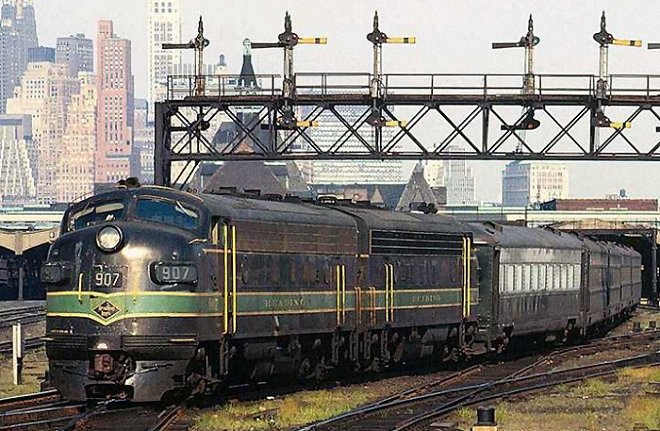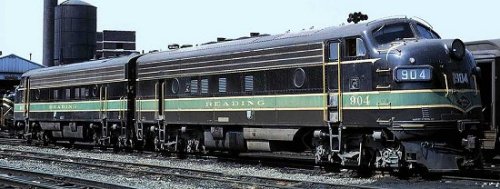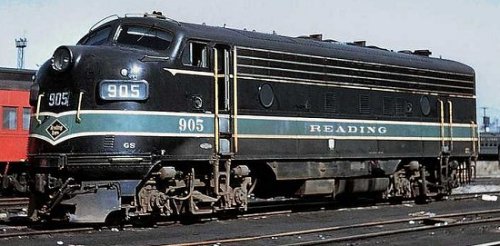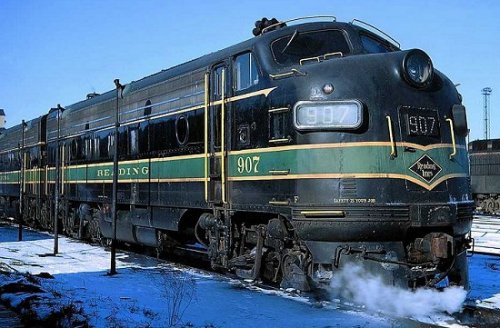EMD: FP7

The Reading rostered 8 EMD FP7 locomotives. Classed DP-1 (Diesel, Passenger, first type), these units were numbered 900 through 907, and were the only diesels purchased by the Reading intended solely for passenger service. The first six units entered into service in 1950, while 906 and 907 arrived on the property in the fall of 1952. Delivered in the same paint scheme as the road's other cab units, the FP7s were four feet longer than the F7s to allow for a steam generator for passenger car heat. Also, these units did not have dynamic brakes, so there were only 4 visible fans on the roof of the carbody. Finally, the FP7s carried Nathan 5-chime air horns, instead of the single-chime horns of their freight-only counterparts. When evaluating the dieselization of its passenger operations, the Reading considered acquiring E8s; however, the versatility of operating the FP7s in pairs won out over using a single E8 locomotive.
 The FP7s were initially put into service in pairs powering the famed stainless-steel Crusader train. Shortly thereafter, they began to power the Wall Street. When 906 and 907 arrived in 1952, this allowed the Reading to dieselize the Schuylkill and King Coal trains from Philadelphia to Pottsville/Shamokin. The FP7s were not used to power Bethlehem Branch or Crossline trains, though it would have been impressive to see the Queen of the Valley storming along the Lebanon Valley Branch behind a pair of FP7s!
The FP7s were initially put into service in pairs powering the famed stainless-steel Crusader train. Shortly thereafter, they began to power the Wall Street. When 906 and 907 arrived in 1952, this allowed the Reading to dieselize the Schuylkill and King Coal trains from Philadelphia to Pottsville/Shamokin. The FP7s were not used to power Bethlehem Branch or Crossline trains, though it would have been impressive to see the Queen of the Valley storming along the Lebanon Valley Branch behind a pair of FP7s!
 In the early 1960s, the Reading's passenger services began to decline with the loss of Railway Express Agency and US Postal Service contracts. To reduce costs and streamline operations, the Reading purchased self-propelled RDC cars. While the initial change was to put the RDCs in service on passenger trains that had been hauled by road switchers, it eventually impacted the FP7s in the mid-1960s, when RDCs replaced them on the New York runs. At the same time, the Reading instituted the "push-pull" train between Reading and Philadelphia, using an FP7 on each end of the train connected by an MU cable. This service continued until the end of passenger service to Reading in 1981.
In the early 1960s, the Reading's passenger services began to decline with the loss of Railway Express Agency and US Postal Service contracts. To reduce costs and streamline operations, the Reading purchased self-propelled RDC cars. While the initial change was to put the RDCs in service on passenger trains that had been hauled by road switchers, it eventually impacted the FP7s in the mid-1960s, when RDCs replaced them on the New York runs. At the same time, the Reading instituted the "push-pull" train between Reading and Philadelphia, using an FP7 on each end of the train connected by an MU cable. This service continued until the end of passenger service to Reading in 1981.
 Reading FP7s 904 and 905 were scrapped in 1965-1966, and 906 was traded to EMD the following year toward the purchase of the SD45s. In 1970, locomotives 901 and 907 were traded to EMD, leaving only 900, 902 and 903 on the roster. Two units powered the "push-pull" train, with one unit held in reserve to be rotated in and out as needed. The three remaining FP7s were conveyed to SEPTA and survive to this day. Locomotives 902 and 903 have been restored to operating condition in their original Reading livery, while 900 is awaiting restoration.
Reading FP7s 904 and 905 were scrapped in 1965-1966, and 906 was traded to EMD the following year toward the purchase of the SD45s. In 1970, locomotives 901 and 907 were traded to EMD, leaving only 900, 902 and 903 on the roster. Two units powered the "push-pull" train, with one unit held in reserve to be rotated in and out as needed. The three remaining FP7s were conveyed to SEPTA and survive to this day. Locomotives 902 and 903 have been restored to operating condition in their original Reading livery, while 900 is awaiting restoration.
MODELING NOTES: When modeling the FP7s, remember that these units were four feet longer than freight units. Some F7 models have steam generator details cast in the shell to try to pass as a passenger unit. Also, the FP7s did not have dynamic brakes and should only have 4 visible fans. Be sure to add the proper Nathan M5 air horn, along with the additional grab irons and other body details. Since these units serviced some of the Reading's premier passenger trains, they were generally kept fairly clean "in their prime," though age and exposure did take their toll in later years. Operationally, these units were used on the New York line and Main Line trains, they did not see service on the crossline. Also be mindful of the scrapping/trade-in dates noted in the text. The FP7s added an elegant touch to the Reading's passenger service, and will be a striking addition on your layout, set against the utilitarian Pullman Green of road switchers and passenger cars!
Did You Know?
Downloads
 A variety of Reading Company operations related documents, etc. that may be of use in your modeling efforts.
A variety of Reading Company operations related documents, etc. that may be of use in your modeling efforts.
 A variety of Reading Company operations paperwork, such as train orders, clearance forms, etc. that will help you operate your Reading layout in a prototypical manner.
A variety of Reading Company operations paperwork, such as train orders, clearance forms, etc. that will help you operate your Reading layout in a prototypical manner.
 Public Timetables, Employe Timetables, and Rulebooks that provide much useful operational information.
Public Timetables, Employe Timetables, and Rulebooks that provide much useful operational information.
 Signs, billboards, and other FREE goodies for your use. We ask only that you help spread the word about The Reading Modeler!
Signs, billboards, and other FREE goodies for your use. We ask only that you help spread the word about The Reading Modeler!

